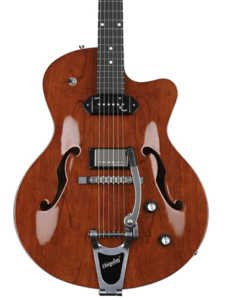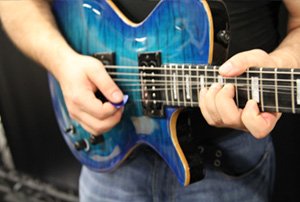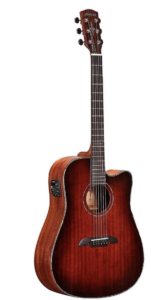 Playing minor scale on a guitar is a basic skill that you need to become a good guitar player.
Playing minor scale on a guitar is a basic skill that you need to become a good guitar player.
The minor scale is a common sequence of notes appearing on popular and classical music. The scale is defined typically using as example the A minor scale.
If we start from the note A, the minor scale is given by the following notes:
A, B, C, D, E, F, G
As you can see, these notes all appear also in the major scale for the key of C.
That’s why we say that A minor is a relative tonality to C major: they have the same notes, differing only where the scale starts.
Intervals in the Minor Scale on a Guitar
Now, considering the intervals of the minor scale, you have the following sequence:
- from A to B, a whole tone.
- starting from B to C, a half tone.
- from C to D, a whole tone.
- starting from D to E, a whole tone.
- from E to F, a half tone.
- starting from F to G, a whole tone.
- from G to A, a whole tone.
Soloing Over Chords on a Minor Pentatonic Scale
Practice Your Guitar in Just 20 minutes
Top Tips to Play Guitar Chords
20 Best Guitar Chords for Beginners
Minor Scale on C minor
Using the intervals presented above, one can build a minor scale starting on C.
The resulting notes are the following:
C, D, Eb, F, G, Ab, Bb
Minor Scale Guitar Shape
 To play the minor scale on a guitar, we need to find a shape for the scale.
To play the minor scale on a guitar, we need to find a shape for the scale.
The following shape can be used, starting on the fifth string:

You can also use this shape starting on the 6th string:

Another position you can use is starting on the 4th string (this time for E minor):

Using these shapes, you can play any minor scale.
Variations of the Minor Scale
Unlike the major scale, the minor scale has variations that many guitar players use.
The main form of the minor scale, seen above, is known as the natural minor.
But there are other two forms of the natural scale: the harmonic minor and the melodic minor.
Harmonic Minor
 The harmonic minor is a variation of the natural scale, where one can raise the 7th degree of the scale.
The harmonic minor is a variation of the natural scale, where one can raise the 7th degree of the scale.
For example, in the C minor scale, the 7th degree is Bb. To make an harmonic minor scale, you need to raise the note Bb to B.
The reason why this is important is that the B note is known as the leading tone. Being half a tone below C, you can easily move from B to C.
The othe reason is that B is the major third of G7. With the B note, we’re now able to use a G7 chord, which is the dominant of C minor.
Without B, you woun’t be able to play a G7 chord, which means that there would not be a dominant chord. This is the reason why this form of the minor scale is called harmonic minor: it helps to improve the harmony.
Melodic Minor
The other variation of the minor scale is the melodic minor. The melodic minor raises not only the 7th degree, but also the 6th degree.
This means that the notes of the C melodic minor scale are:
C, D, Eb, F, G, A, B.
Notice that these notes are almost the same as C major key, with the exception of the minor third (Eb instead of E). This makes this scale very useful in certain contexts.
 To play a minor melodic scale on guitar, you can use the following pattern of whole and half steps:
To play a minor melodic scale on guitar, you can use the following pattern of whole and half steps:
Start on the root note of the scale.
Then Move up a whole step to the second note of the scale.
Next, Move up a half step to the third note of the scale.
Now, Move up a whole step to the fourth note of the scale.
Then, Move up a whole step to the fifth note of the scale.
Next, Move up a whole step to the sixth note of the scale.
Now, Move up a whole step to the seventh note of the scale.
Finally, Move up a half step to the octave of the root note.
For example, to play an A minor melodic scale, you can start on the low E string at the 5th fret (which is an A), and then follow the above pattern to play the rest of the scale. The scale would be: A, B, C, D, E, F#, G#, A.
Keep in mind that this is just one way to play a minor melodic scale on guitar. There are many different fingerings and positions that you can use to play the same scale. Experiment with different patterns to find what works best for you.

